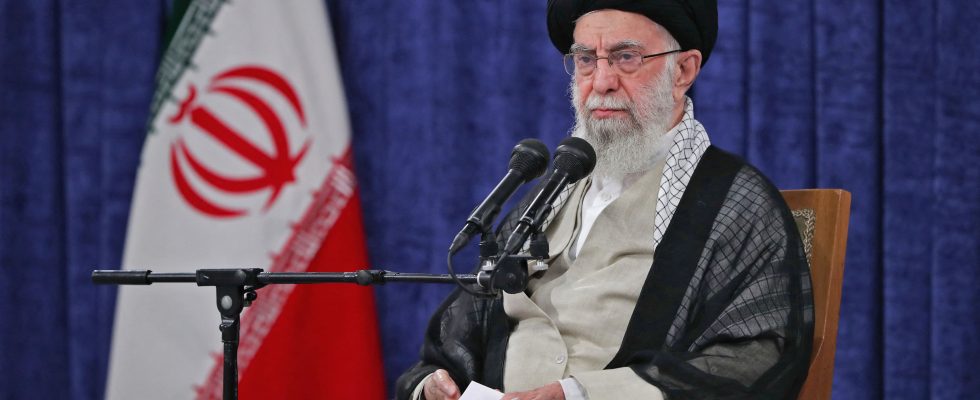After forty-five years of existence, how does the Islamic Republic of Iran function today? What are the workings of its system, and how does it maintain itself despite the hostility of a large part of the population, a strong regional rivalry with Saudi Arabia, and an uncompromising hostility towards Israel? and the United States? For his work, The Hidden Face of the Mullahs: The Black Book of the Islamic Republic of Iran (ed. Cerf), Emmanuel Razavi, an excellent expert on the Middle East where he has been reporting for thirty years, has met many players in the region. In his book he deciphers an entire mafia system, very largely controlled by the Revolutionary Guards (the militia serving the Supreme Guide), which allows the Islamic Republic to survive.
On March 1, Iran experienced the first elections since the protest movement of fall 2022. Iranians were called to the polls for two ballots: the Assembly of Experts, a council of clerics responsible for electing the Supreme Guide ( the current Guide Ali Khamenei is 84 years old), and the Parliament. The official participation rate indicates around 40% of the 61 million voters, the lowest figure since the beginning of the Islamic Republic, but this is difficult to verify. In both elections, most non-ultraconservative candidates were disqualified.
“The regime is over, but they don’t know yet”: this is a phrase that Emmanuel Razavi often heard during his investigation, for which he questioned not only members of the opposition but also relatives or former relatives of the Islamic Republic. At the origin of his book project, documents he received, pointing to sums of money smuggled out of Iran. True or false ? Difficult to decipher for the seasoned journalist. “The sums were so staggering that it seemed implausible.” But even if the story is false, he said to himself, “if people take the time to come out with false stories, something must still be happening.” The only option is to investigate. Faithful to his method, the great reporter, who regularly publishes in Paris Match, relies on the terrain. Experiences that he combines with the conclusions of carefully chosen experts.
“I wanted to do the work of a reporter not by giving my point of view, but by reporting what I observed. I first did an investigation into drug traffickers, a traffic organized by the Revolutionary Guards with Hezbollah, and takes stock of all the methods of laundering this drug money. Because this money, obviously, does not go into the Iranian economy. I realized that it was placed in Turkey, particularly in real estate programs. Information verified thanks to contacts, one of them having been part of the Revolutionary Guards and having himself participated in the money laundering system.”
Several months of investigation were necessary: “I never took what was said to me at face value,” explains the journalist. It reveals how the Revolutionary Guards use the company Mahan Air to carry out clandestine flights which allow them to take their fortune out of Iran. “Almost a spy film” to be able to trace these networks. “The Iranian regime today is a mixture of the Corleone family and the Nazi regime. Why Corleone? Because when the war between Iran and Iraq broke out in the early 1980s, the Revolutionary Guards who have just been formed, will distinguish themselves on the front. They will return to Iran at the end of the war, crowned with the almost mythical figure of the hero who saved the country. The government will then put in place a whole system of subsidies which will allow them to create businesses. They have thus begun to amass a financial nest egg which has given them economic power.” From this economic power will result an increasingly strong hold on the country, perfectly described in The Hidden Face of the Mullahs.
A terminally ill diet
Emmanuel Razavi also looks back on his interviews with the different parts of the Iranian opposition, reporting their motivations and their ambitions for the country. “It’s my role as a journalist to try to give everyone a voice,” he says. Whether it is the Kurds of the Democratic Party of Kurdistan of Iran who are fighting for the autonomy of the Kurdish people, or the monarchists, and in particular the exiled crown prince Reza Pahlavi. This opposition, which still has multiple contours, outlines an Iran of possibilities.
In the background of this work on the workings of the Islamic Republic, the people who face it, and in particular the “Women, Life, Liberty” movement, which had a great impact on Emmanuel Razavi, himself of Iranian origin and particularly touched by the history of the country. At the origins of the adoption of the Islamic veil in the Republic founded by Khomeini, he notes, “is the idea that Islam must occupy all visual space. Veiling women is putting the Islam everywhere in the streets.”
His book also shows that many Iranians are worried about confrontation with the West, which Islamic power has erected as a totem. “There is a fear, among some who are part of the system, that by going too far, the West will end up saying stop. Iran could then expose itself to the risk of bombing. And the country is not equipped to hold.” “The regime makes the whole world believe that it is still powerful even though it is in a terminal phase. It maintains itself through violence, inside the country with repression, but also through violence outside. As long as the West has not taken stock of its fragilities, the Islamic Republic will persist,” warns the journalist. What will bring down the mullahs? No doubt “the generational divide” he suggests, an intuition confirmed by his contacts on site. Iran, populated by 88 million people, has a population whose average age is 32 years old. “These young people no longer want political Islam. We cannot go against developments, sociological mutations. It will perhaps last three years, four years, five years, but no more.”
.
